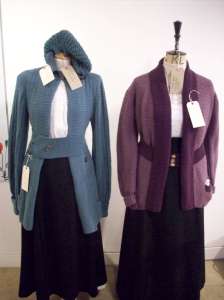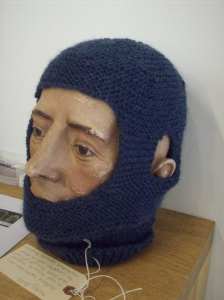One of my lovely gardening clients, who knows I’m a crochet addict, told me of an exhibition she’s heard about on the radio called Centenary Stitches. It sounded very interesting, and I was keen to go. Finding out it was in Lincoln, I figured it was a bit too far to visit just for an exhibition! But then I remembered I had some money-off vouchers from a delayed train journey in the summer, so I decided to use them to day-trip halfway up the country especially. And I’m glad I went – it was a small exhibition, but I spent nearly an hour and a half having a good ol’ rummage around.
The Centenary Stitches project grew from the costuming of a community film called Tell Them of Us. The aim was to create something centred around the war story of ordinary people, not celebrated already by fame or high rank. But these are the people about whom there is typically less documentation. However, one family – the Crowders from the village of Thimbleby in Lincolnshire – had maintained a comprehensive archive containing letters, memoirs and scrapbooks, photos and other items from the Great War years. From this family archive, a script and screenplay developed.
If the stories of everyman are difficult to discover due to lack of records, costuming and clothing can be even more tricky. Fabrics are fragile, especially the woollens, being susceptible to moth damage or easy to repurpose, for example, through felting. Photographic evidence provides little more information, as these tended to record special events rather than daily attire. Knitting patterns from the era are a more reliable source, though these are problematic for the 21st century yarner thanks to the difference in culture; in the early 20th century, most girls were schooled in knitting and crochet, so patterns didn’t need the details required by many today. For instance, sock instructions could use the short-hand “turn the heel” and the reader could proceed without panic and you-tube how-to guides. Some of the items in this exhibition are clothes crafted for the film, but there are also reproductions of other items from World War One.
There are two woolly stories to be told here: one is military – how knitting affected the lives of troops at the Front; the other is social – the tale of women and how their clothing reflected their increasing emancipation.
Military uniforms were not enough for the needs of the soldiers, and were supplemented with knitted accessories that came to be known as ‘comforts’. These were sent by women to their loved ones in the trenches, but also distributed by organisations like the Red Cross and Regimental Comforts Fund. Such items included scarves, gloves, balaclavas and smooth-seamed socks. Lord Kitchener, British secretary of state for war and the face of “Your Country Needs You” posters, is credited with the invention of an invisible grafted toe seam which helped prevent blisters – sock patterns of the time were made with a seam up the toe that tended to cause chafing. Among the more unusual knits were knee warmers, often worn over bandages in hospital, and rifleman’s gloves without thumb and trigger finger. Despite the value of their endeavours, many of the crafters put themselves down as being just a “Sister Susie”, and denigrated their war work , believing it to be a minimal contribution because they did not suffer or don a uniform. But VAD nurse Olive Dent noted otherwise in her diary: “We nurses know how much the gifts and comforts are appreciated… Every stitch..meant a few minutes greater comfort – and correspondingly less pain – from an aching body tortured on our behalf, for our defence and birthrights.” She goes so far as to say that these Sister Susies performed “some of the most valuable war service”.
The process of women becoming more active participants in society, in roles that were previously denied them, meant that their clothes had to change. Greater freedom of movement became necessary. There was a shift from garments which needed to be clung to like the shawl, to those such as jumpers and cardigans. Women started to ditch the restrictive corset and this was hastened by metal shortages brought about by the war – metal, of course, was needed to construct the framework of corsets. Apart from maintaining a rigid, upright posture, corsets also provided an insulating layer to the torso so all that would be required to stave off the chill might be a shawl. Without this thermal layer, those same garments enabling freer movement, the waistcoats etc, became fundamental for warmth.
The costume design for the film was based on original knitting patterns from the Edwardian period as well as photographs of the eldest Crowder sister, Grace, whose clothing was ‘reverse-engineered’ by specialist knitters. Looking around the exhibition, most of the items were knitted which is hardly surprising given that, traditionally, crochet uses more yarn, which isn’t conducive to the frugality that the war demanded. One of my favourite pieces was a knitted wrap waistcoat.
Its maker said she was excited to see the way garter stitch was used in this pattern because people usually think garter stitch is boring. It has a crocheted embellishment on the belt, which I liked. Other crocheted items included a bag, shawls and hats. The most surprising item was a tie done in Tunisian crochet, certainly an unusual technique today as I suspect it was then, too.
Commemorating a war through its woolies is an unusual venture, perhaps deemed too trivial in comparison with the horrors endured by the soldiers, or not dramatic enough to be considered. But knitting and crochet really did play an important, if understated, role.
Further Reading
http://www.centenarystitches.wordpress.com
Jane Crowfoot, The Kitchener Stitch, in The Knitter, Issue 19






